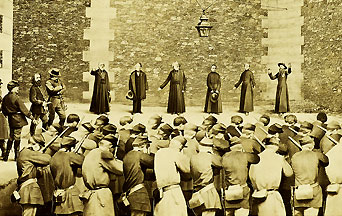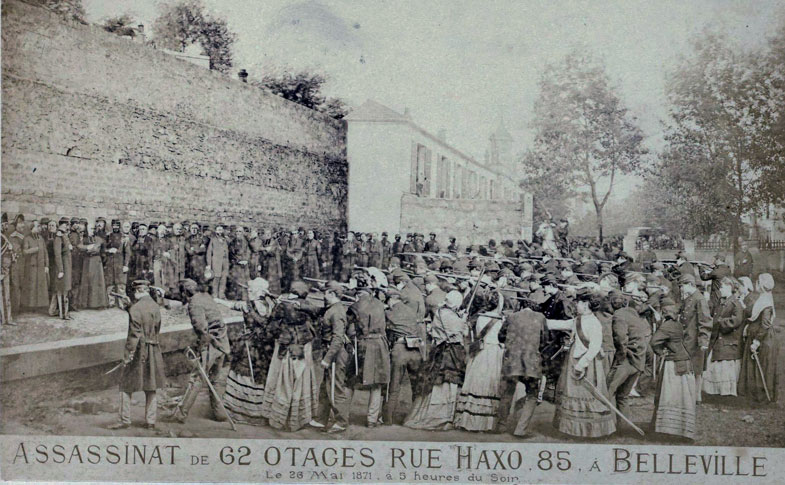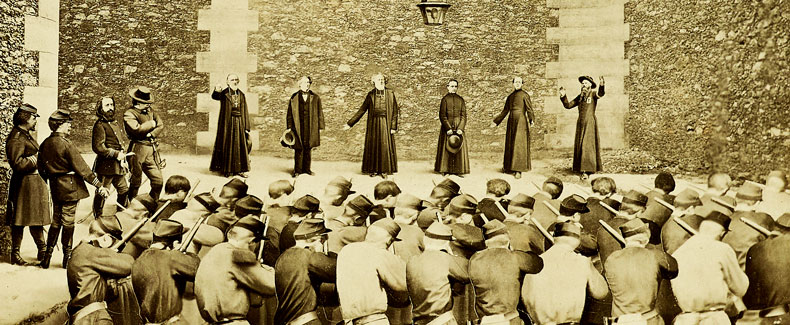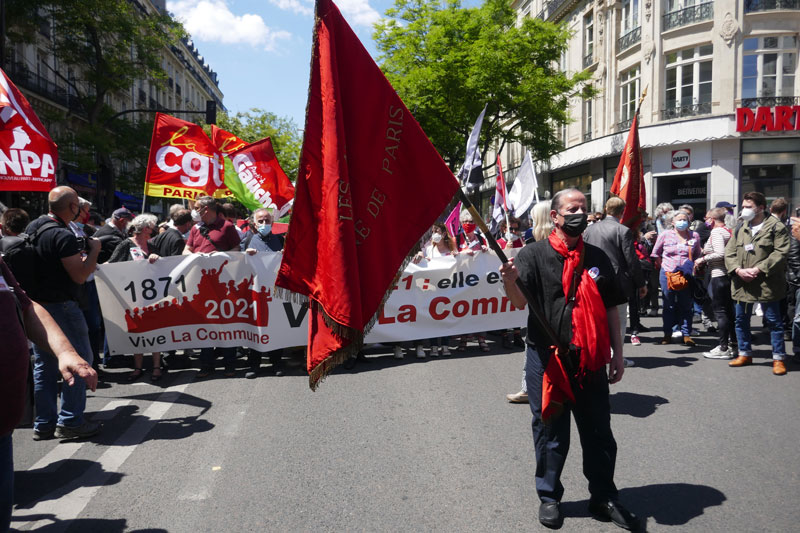
Religious Persecution, the Forgotten Aspect of an Episode That Became an Icon of the Left
On Saturday, May 29, 2021, Catholic parishes in the 20th district of Paris organized a pilgrimage to honor the memory of Archbishop Georges Darboy, several priests and other religious killed by members of the Paris Commune in 1871. The historic episode became known as the “Haxo Street Massacre.” About 300 faithful Catholics, priests and religious took part in the pilgrimage/procession, led by the auxiliary bishop, Most Rev. Denis Jachiet.
The destination of the 2.5-mile procession was the parish of Our Lady of Hostages. The church marks the spot where, 150 years earlier, forty-nine hostages, including ten men religious, were shot by Communards—the atheist, anticlerical activists of the Commune. No sooner had the procession started than passersby and people sitting at tables in open-air cafes began to jeer and insult the faithful.
A Peaceful Procession Interrupted by Violence
The procession continued undaunted. A hundred yards ahead, it passed the Père Lachaise cemetery where pro-commune demonstrators waited. Carrying red flags, they tried to stifle the religious hymns of the faithful with the menacing slogans: “Down with the clergy!” “Death to Fascists!” These same agitators had just taken part in a leftist demonstration to commemorate the “martyrs of the Commune,” who were killed in the provisional government’s bloody repression of the revolutionary movement.
The procession was then interrupted by the twenty hooded youths shouting “antifa” slogans.
Catholic Procession to Our Lady of Hostages Is Attacked by Pro-commune-ists
The taunts, insults and threats quickly degenerated into physical violent aggression against those in the Catholic procession. The aggressors threw objects and beat the participants to the point that many were hurt and had to be rescued by the Order of Malta’s medical team. A sixty-year-old man was severely hit in the head and hospitalized.
The few security guards provided by the diocese and the Order of Malta were quickly overwhelmed. The only two police officers present called for reinforcements. They resorted to tear gas as the only way to separate the aggressors from the faithful.
To avoid worse violence, the faithful ended the procession by taking refuge in the nearest church, Our Lady of the Cross. They waited in prayer until the police released them.1
Not Merely Political, but Metaphysical and Theological Antagonism
Reporters from the leftist and secularist intelligentsia sought to attribute a political character to the Catholic procession. They claimed that traditionalist Catholics, “linked to the extreme right,” took advantage of the Paris Commune’s 150th anniversary to hold a rally under the guise of a religious act.2
Nothing could be farther from the truth. The pilgrimage only visited places linked to the martyrdom of priests and religious during the Paris Commune. Mainstream parishes of the Paris Archdiocese promoted the event without any participation of groups related to “traditionalist” Catholic circles. Furthermore, its stated goal was strictly religious: to honor the martyrs in order to foster devotion to them and advance the cause of their beatification.3
However, the antagonism between the two groups reflects a deep divide in France that goes much beyond mere political disagreement. The two sides represent two opposing views of man and the universe. One side reflects the remnants of a hierarchical and sacral worldview inherited from the Middle Ages. The other is an egalitarian and secularist vision born of the French Revolution.
A Nation Divided by a Furrow of Blood
Two opposed and irreconcilable “Frances” emerged from the conflict between these two incompatible Weltanschauung. As Churchill eloquently put it, France became a nation divided by a furrow of blood—the bloodshed in the French Revolution in 1789.4

That division only became worse with the 72-day takeover of the Paris Commune. This revival of the French Revolution sparked the massacre of thousands of civilians and scores of men and women religious, especially during the “Bloody Week” (May 21-28).
The procession and the anarchical protests commemorated the opposing events of that bloody episode in French history.
Heirs to the French Revolution
The Paris Commune is the direct descendent of the egalitarian and libertarian principles of the French Revolution. Its proponents sought to complete the work begun in 1789. They considered the military coup that gave rise to the Napoleonic regime and what followed as a mere interruption.
The 1871 Communards are linked with eighteenth-century Jacobins not only by their doctrines and program but even the name Commune refers to the insurrectionary Commune that ended the French monarchy on August 10, 1792.
The revolutionary principles of the French Revolution remained in the nation’s veins, like incubating germs that caused spasmodic outbreaks. Thus, after Napoleon, the Liberal Revolution of 1830 ended the Bourbon Restoration, which tried unsuccessfully to reconnect post-revolutionary France with the Ancien Régime. Later, the 1848 revolution overthrew the liberal “July Monarchy” and led to the Second Empire of Napoleon III. The empire fell in 1870, and the revolutionary ferment reappeared in the French Commune. A later manifestation of this ferment is the May 1968 Sorbonne Revolution. With its slogan “défense d’interdire” (“it is forbidden to forbid”), the event inaugurated the present era of political, social and moral libertarianism.
A Dechristianized City, Nest of Revolutionary Groups
The Paris Commune took place at a time of protracted religious and moral decadence. Paris was a de-Christianized city where only 15% of its population of 1.8 million souls regularly practiced religion.5
The “City of Lights” was an incubator for revolutionary groups and movements of all hues. It was full of secret societies and clubs. Anarchists, communists, socialists, Blanquists (revolutionary socialists), anarcho-unionists, anticlerical republicans and secularists flocked to the city.
Revolutionary agitators indoctrinated workers with their propaganda.
The Commune Is Proclaimed
In early September 1870, the Prussians defeated Napoleon III at the Battle of Sedan. A Republic was proclaimed as the Prussians invaded France’s northern half and besieged its capital. Parisians had to bear long months of hunger and cold. In these dramatic conditions, the population was divided between those favoring an armistice and those resolved to resist at all cost.
In January 1871, the provisional government, headed by the liberal historian and politician Adolphe Thiers, concluded an armistice with Bismarck. That surrender led to the Germans’ humiliating military parade into the capital.

Anticipating an insurrection, the French provisional government and regular troops retreated to Versailles, leaving the capital at the mercy of well-organized leftist groups ready to seize power.
The 180,000 men-strong National Guard refused to accept defeat and vowed to continue the fight. On March 18, the Thiers government’s attempt to seize the National Guard’s 200 canons by force lead to an insurrection that resulted in the official proclamation of the Paris Commune on March 28.
A brief but cruel civil war ensued, pitting the Communards (also called federates) against the Versaillians, loyal to Thiers’ provisional government.
Repression
On May 21, General Patrice de Mac-Mahon entered Paris by overcoming over 500 barricades erected in all its arrondissements (administrative districts). He invaded the city and recaptured every borough. Massacres multiplied. Monuments are burned or destroyed, including City Hall, the Tuileries Palace, and the Place Vendôme column celebrating Napoleon’s victories. On May 28, 1871, the general crushed the last resistance, leaving a toll of between 8,000 and 20,000 dead.
There were about 40,000 revolutionary prisoners, most of whom were tried by war councils. Many are sentenced to imprisonment or deportation to Algeria or New Caledonia. Some were condemned to forced labor, while a few hundred received the death penalty.
The so-called Bloody Week (May 21-28) marked the end of the Commune.
Revolutionary Measures and the Specter of the Comités de Salut Publique
What most people do not know about the Paris Commune is its radical agenda. In the short span of 72 days, the Commune held 57 legislative sessions in which they passed revolutionary measures that clearly show France’s fate had the dictatorial regime prevailed. Fortunately, it only had time to implement a few of its decrees. However, the Third Republic later enacted others.
Upon taking power, the Commune created surveillance committees in all the arrondissements, a revival of the French Revolution’s Committees for Public Safety. A central committee controlled the network made up of revolutionaries from many extreme left-wing currents.
“Long Live Christ the King!” Young Mexican, Authentic Model of a Catholic Hero
The Commune unilaterally terminated the 1801 Concordat with the Church. It then decreed the separation of Church and State and nationalized church property. It further suppressed religious teaching in schools and established free, secular, and compulsory public education. In some neighborhoods, churches were allowed to hold religious services during the day but had to open their doors at night for political meetings. Churches became the Commune’s main political centers.
The Commune symbolically adopted a red flag instead of the tricolor and reestablished the long-discarded First French Republic’s calendar.
A Symbolic Event
Since the defeat of the Commune, anarchists, socialists, communists and other revolutionaries have continually sung its praises in verse and prose. Its mention has become the boilerplate of the speeches and writings of communist leaders.

Photo Credit: Jeanne Menjoulet from Paris, France, CC BY 2.0
In 1966, Mao often associated the Commune name with his Cultural Revolution. Lenin joined Marx in considering the Commune to be a real example of the dictatorship of the proletariat. He also wanted his body buried shrouded in a rescued ragged red flag from the Commune.6
The Soviets honored the Commune by carrying a piece of one of its flags aboard the Voskhod 1 spacecraft. The Bolsheviks also renamed the Sebastopol battleship “Parizhskaya Kommuna.”7
All this Revolutionary lyricism omits one key aspect of this symbolic event: its persecution of the Church.
Persecuting the Church
The bloody persecution of the Church was not the work of a few hotheads or an unfortunate “bump in the road.” It was the inevitable consequence of the clash between the two antagonistic views of man and the universe mentioned above.
After only three weeks in power, the Commune started its violent persecution against the Paris clergy. It had already subjected churchmen to humiliating measures. They were “accused of complicity with feudal, capitalist, Bonapartist or Versailles oppressors.”
In early April, priests exercising their (increasingly underground) ministry were forced to abandon their cassocks and dress in civilian attire. Nuns had to give up their habits. Even the Sisters of Charity, who were protected because of their service to the community, could not wear their habits. With a heavy heart, the clergy acquiesced to these demands to continue their activities and protect themselves from insults and violence.8
A decree of April 5, 1871, declared that “all persons accused of complicity with the government of Versailles will be hostages of the people of Paris.” The same decree also specified that “any execution of a prisoner of war or a supporter of the Paris Commune will be immediately followed by the execution of three times the number of hostages held … and they will be designated by lot.”9
Learn All About the Prophecies of Our Lady of Good Success About Our Times
As Holy Week began, this decree that was called the “Cassock Razzia” was implemented. Some 200 priests, including the Archbishop of Paris, Georges Darboy, were thrown into prison and declared hostages. The Communards offered President Adolphe Thiers to release the archbishop in exchange for the revolutionary Louis Auguste Blanqui, imprisoned in a fort in Brittany. Thiers categorically refused.
Saint-Hilaire, Thiers’ secretary, summarizing the president’s opinion, replied to those concerned about Versailles’ refusal to exchange even seventy-four hostages, including the archbishop, for the revolutionary leader Blanqui: “The hostages? Too bad for them! Politically, their death will be a good deal.”10
On April 4, the federates attacked the Jesuit house at Rue de Sèvres. Fathers Olivaint and Caubert hastily placed a consecrated host under their clothes. They were taken together to Mazas, a prison already holding other priests. They were held incommunicado and prohibited from celebrating Mass. On May 22, most prisoners were transferred to Grande Roquette Prison, reserved for those sentenced to death. Two heroic women managed to pass consecrated hosts to the Jesuit Fathers just before they left that prison.11
On the dark night of May 24, the federates gathered together Archbishop Darboy, Father Deguerry, and three Jesuits and summarily executed them in a narrow prison corridor.
On May 26, they called ten hostages. The priests joined four civilians and a group of thirty-five national guardsmen. The sad procession left the prison toward the 20th arrondissement, a couple of miles away, under insults and threats: “Death to priests! Death to Gendarmes!”
Our Lady of the Grand Return: A Story of Hope for our Times
A music band led the procession. As the crowd became more compact and overexcited, it arrived at Haxo Street, where the Commune leaders were waiting. Around 5 p.m., the leaders gave the federate men and women the order to attack the hostages with rifles, revolvers, sabers and bayonets. They attacked Father Tuffier, an elderly Sacred Heart priest, with particular virulence. He responded with a blessing. The great massacre lasted a quarter of an hour.
To hide their crime, the federates threw the bodies into a well. On Pentecost Monday, some relatives learned of the massacre, found their corpses and returned each of them to his congregation, parish or family.
People soon proclaimed them as martyrs killed during the Paris Commune “in odium Fidei.” Later, a church was built on the site of their martyrdom. It was appropriately dedicated to Our Lady of Hostages—the final destination of the Parisian faithful on their pilgrimage of Saturday, May 29, 2021—had they not been attacked.
France remains a nation divided by a furrow of blood and will find no unity or harmony as long as this blood does not turn into the seeds of Christians. Nor will she resume the grandiose role Providence assigned to her as the “first-born daughter of the Church.”
Footnotes
- Edna, “A procession in memory of the Catholic martyrs of the Municipality attacked by antifas,” News in 24, https://news.in-24.com/news/39710.html, accessed June 17, 2021 4:46 PM; Elisabeth Pierson, “Paris: une procession en mémoire des martyrs catholiques de la Commune attaquée par des antifas,” Le Figaro, May 30, 2021, https://www.lefigaro.fr/paris-une-procession-en-memoire-des-martyrs-catholiques-de-la-commune-attaquee-par-des-antifas-20210530, accessed June 17, 2021 16:25; Famille Chrétienne, “Paris: une procession catholique violemment attaquée par des antifas,” May 30, 2021, https://www.famillechretienne.fr/36589/article/paris-une-procession-catholique-violemment-attaquee-par-des-antifas, accessed June 18, 2021 12:48; Cécile Chambraud, “Débat chez les catholiques autour de la commémoration de prêtres tués par les communards,” Le Monde, June 7, 2021, https://www.lemonde.fr/societe/article/2021/06/07/debat-chez-les-catholiques-autour-de-la-commemoration-de-pretres-tues-par-les-communards_6083191_3224.html, accessed June 21, 2021 13:01.
- Théo Moy, “La marche pour les prêtres tués lors de la Commune de Paris était-elle une provocation?” Marianne, June 1, 2021, https://www.marianne.net/societe/laicite-et-religions/la-marche-pour-les-pretres-tues-lors-de-la-commune-de-paris-etait-elle-une-provocation, accessed June 17, 2021 16:53.
- CNA Staff, “Paris archbishop laments attack on Catholics honoring city’s martyrs,” May 31, 2021, https://www.catholicnewsagency.com/news/247843/paris-archbishop-laments-attack-on-catholics-honoring-citys-martyrs; Théo Moy, op. cit.; Edna, op. cit.
- Cited by Plinio Corrêa de Oliveira, Minha Vida Pública, Part VII, Chapter IV, https://www.pliniocorreadeoliveira.info/Minha_Vida_publica/MVP_10_Viagens_de_1950_1952_Europa.htm#_Toc451114412, our translation.
- BasKulture, “La Commune de Paris et l’assassinat de Mgr Darboy,” April 2, 2021, https://www.baskulture.com/article/la-commune-de-paris-et-lassassinat-de-mgr-darboy-3823, accessed June 21, 2021 15:06.
- Hugh Schofield, “Paris Commune: The revolt dividing France 150 years on,” BBC News, March 18, 2021, https://www.bbc.com/news/world-europe-56426710, accessed June 17, 2021 10:28 AM; Fideus, “Comuna de Paris,” https://www.fideus.com/esdeveniments%20-%20comuna%20de%20paris.htm, accessed June 20, 2021 18:43.
- Fideus, ibid.
- Anne Bernet, “Ces prêtres victimes de l’anticléricalisme des Communards… et des Versaillais,” Aleteia, May 24, 2021, https://fr.aleteia.org/2021/05/24/en-1871-ainsi-moururent-les-premiers-pretres-victimes-de-lanticlericalisme-des-communards-et-des-versaillais/, accessed June 21, 2021 18:15.
- Solène Tadié, “Remembering the Catholic Martyrs of the Commune of Paris,” National Catholic Register, May 28, 2021, https://www.ncregister.com/news/remembering-the-catholic-martyrs-of-the-commune-of-paris, accessed June 23, 2021 4:24 PM.
- Anne Bernet, ibid.
- Noémie Bertin, “Prêtres emprisonnés, moines fusillés… Les martyrs oubliés de la Commune de Paris,” Famille Chrétienne, May 14, 2021, https://www.famillechretienne.fr/36519/article/pretres-emprisonnes-moines-fusilles-les-martyrs-oublies-de-la-commune-de-paris, accessed June 18, 2021 15:36.
